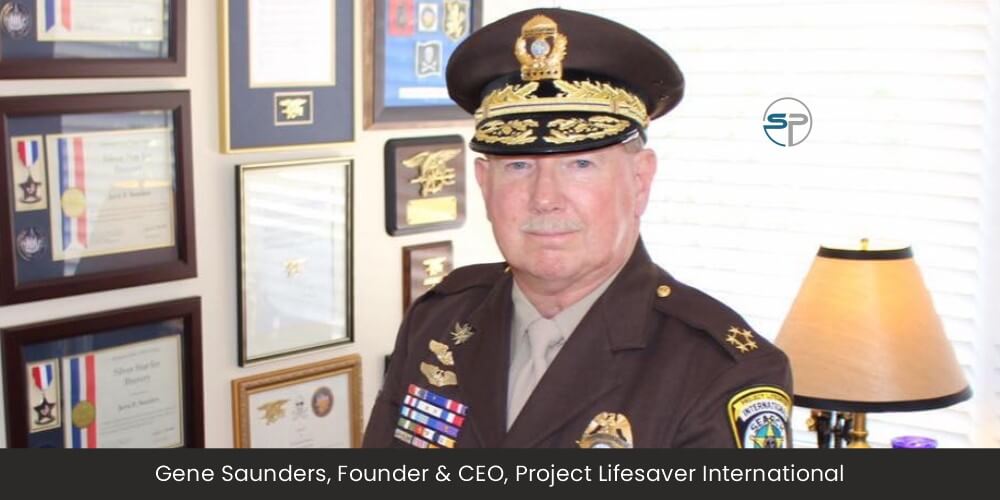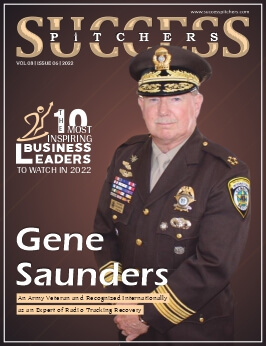Gene Saunders: An Army Veteran and Recognized Internationally as an Expert of Radio Tracking Recovery
The 10 Most Inspiring Business Leaders to Watch in 2022

Served 33 years with the Chesapeake Police Department, serving in Patrol, Vice, Narcotics, Detectives, and Training, Gene Saunders served in line function and command elements of each of these units. He co-founded the Special Weapons and Tactics team in 1974, serving as tactical commander and commander for 23 years with over 800 operations.
Prior to joining the police department, Gene served in the Army National Guard for 14 years, retiring as a major after commanding an infantry and ranger unit. He also worked in other places. He joined the Chesapeake, VA Police Department in 1968 and retired as a Captain in 2001. During his stint with the police department, he worked in patrol as a patrolman, vice, narcotics, training, and homicide robbery as a detective, eventually rising to manage each of these divisions. Because of the growing number of searches for wandering Alzheimer’s patients and the lack of success with traditional approaches, he looked for another means to find people with cognitive problems who strayed. After doing research, he found that radio frequency tracking was the most reliable and simple method to use. Gene established Project Lifesaver in 1999, utilizing that technology and developing training and certification programs for its use. He conducted this program as a volunteer for 2 years before retiring from the police dept. Gene has served as Chief Executive Officer for the organization since its founding 23 years ago.
Gene is recognized internationally as an expert and the father of radio tracking recovery of people at risk. He is the author of several articles for magazines concerning wandering and has appeared on numerous local, national, and international radio and television programs. These include; CBS Early Show, Extreme Makeover Home Edition, Living the Life; Fox News; The Discovery Channel, CNN News, The Daily Buzz, and William Shatner’s “Moving America Forward.”
Vision behind Project Lifesaver International
While with the Police Department, Gene was commander of SWAT and special operations, including search and rescue. He recalls, “We were encountering more searches for missing Alzheimer’s patients, which were requiring more manpower, time, and funding to complete. It should be remembered that at the time, there was very little known about searching for Alzheimer’s patients and the idiosyncrasies associated with those searches.” As a result, these searches frequently yielded less-than-desirable results. The team needed a more positive method of tracking and identifying these folks before they were harmed. Gene stated that the crew had learned that they were working against the clock in each case and that finding a solution quickly was critical.
The Project Lifesaver International team teaches public safety agencies, law enforcement agencies, hospitals, and search and rescue teams how to utilise radio tracking search equipment and how to implement the program in their areas. The training involves familiarisation with the disorders that the agencies will deal with as well as how to engage properly with individuals in the programme as well as others in the community that they may encounter. Once the agency implements the program, it serves as a consultant and mentor to them while they carry out the program, providing training sessions and conferences to keep them up to speed on the issues they will face.
Project Lifesaver International
A public safety program designed to protect and identify people suffering from cognitive diseases such as Alzheimer’s, dementia, autism, and Down syndrome who may wander and become lost.Project Lifesaver teaches search and rescue operations, techniques, and equipment to public safety departments around the country. To date, Project Lifesaver organizations have saved over 2,000 people in the United States, Canada, and Australia, with an average search duration of 30 minutes.
Project Lifesaver was the first to employ such locating tactics to help in the search and rescue of people, and it is the nation’s most frequently used and proven most successful program that is expressly designed to safeguard “at-risk” groups in our communities. The initiative was designed to deliberately integrate cutting-edge locator technology, novel search and rescue techniques, and community policing training that trained first responders on cognitive disorders. The time it takes to find certified Project Lifesaver agencies has been lowered from hours to minutes. Recovery times for agencies using Project Lifesaver are on average 30 minutes, which is 95% faster than typical operations without Project Lifesaver.
Public safety authorities manage the Project Lifesaver Program on a local level. When a government agency agrees to implement the program, Project Lifesaver International will supply the required technology and training to individuals involved. The training comprises the use of the equipment, the application of the program’s strategic techniques, and community policing courses that teach a fundamental understanding of cognitive problems in order to better understand the actions of an individual with such a condition. The usage of the PLS Database, a helpful resource given at no cost to member agencies, is also covered during training. Certification requires the completion of training. After becoming accredited, an agency can begin soliciting customers for their local program.
The technique is based on tried-and-true radio technology and carefully trained search and rescue personnel. Project Lifesaver participants wear a tiny transmitter on their wrist or ankle that emits a unique frequency signal. If an enrolled client goes missing, the caregiver notifies their local Project Lifesaver agency, and a trained emergency team responds to the wanderer’s area. The first responders will then use the client’s individualized frequency to locate the position of the individual. The knowledge given from the community policing courses is best applied in this situation because the first responders will know how to best approach the client once found, and allow them to be brought back to safety.
Leading to Bring Improvement
Gene is in charge of the organization’s everyday operations, including staff and equipment. He oversees training advancements and technological upgrades; conducts research and development on equipment and technology; and manages the organization’s media. He also oversees and implements the organization’s strategic plans. He collaborates with the company’s Board of Trustees to establish policies for the organization’s current and future activities.
Gene is mission-driven, results-oriented, and fair to his employees. He seeks ambitious, inventive people to join the organization and is always looking for ways to improve. He prefers to let workers discover their own solutions to issues and/or circumstances, but will be available to guide or assist when necessary. He states, “I am, according to wife, stubborn and unwilling to bow to those who are naysayers and negative people, which I encountered a lot during the formulative years of Project Lifesaver.”
Recognition throughout the Years
Gene did not choose to be an expert. It came with the program’s creation since no one else was doing what we were doing. He chooses to keep current on technology and methodologies, as well as issues affecting the individuals with whom he and his team work. He has been called on to advise in searches, the formation of programmes to deal with the problem, and to speak on subjects relevant to the area, including conferences, radio, television, podcasts, and magazine articles since the inception of Project Lifesaver. He has written and co-written various essays on the subject.
Gene has received several awards that include the Citizen’s Commendation from the Congressional Medal of Honor Society, CEO of the Year 2021 from the International Association of Top Professionals; and the Lifetime Achievement Award, The Project Lifesaver Medal of Honor from the Board of Trustees; the Year 2019, Hero Award -Bank of America 2009, Person of Distinction CBS Radio 2016, George Washington Foundation Medal of Honor 2021, 3 Silver Stars for Valor, 3 Police Commendation Medals, Chief’s Commendation for SWAT Service, President of the United States Commendation for SWAT service, Marquis International Who’s Who and Hall of Fame, featured in a number of magazine articles, radio shows, TV shows, and a book , “Deploying High” written about me.
Leader’s View
What is the company’s core value as it relates to your customers?
Keeping equipment and methods relevant and timely. Passing along information concerning changes and theories concerning those they will be searching for and interacting with. responding to incidents and/or situations brought to our attention concerning methods, equipment, and training. Making sure our agencies are experts in their field of locating wandering individuals.
What advice would you give to emerging leaders and enthusiasts considering a career in the public safety sector?
Stay abreast of the changing times and the demands of society. Never quit once you start! Do not give in to the negative comments or naysayers who discredit your efforts or dreams.
Where do you see yourself and the company in upcoming years?
Project Lifesaver will continue to improve and develop its equipment to improve capability and ease of use. We will continue to evaluate our methods for improvement and our training to incorporate those things which are necessary for successful operation of the program.
Website: www.projectlifesaver.org










